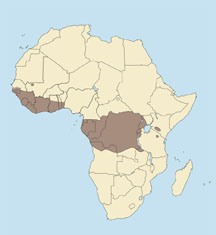 |
Profelis aurata
Gato dorado (Sp), Afrikanische Goldkatze (G), Chat doré africain (F). Aurata is from the Latin aureatus, which means adorned with gold.
DESCRIPTION Head and body length 24-40 lbs (61.6-101.6 cm). Tail length 6-18 inches (15-46 cm). Shoulder height about 15-20 inches (38-51 cm). Weight 12-35 lbs (5-1/2 to 16 kg), though there are very few records. Males are considerably heavier and more powerfully built than females. The female normally has two pairs of teats.
A powerfully built, medium-sized cat with a small head, heavy muzzle, small ears, long legs, large paws and a comparatively short tail. The coloration is highly variable, ranging from reddish-brown to gray. The upper coat may be heavily spotted, partly spotted, or unspotted, but in all cases the white underparts are marked with large black spots. One study of 186 skins found 50% to be reddish, 46% gray and 4% completely black. Animals from West Africa tend to be more spotted than those from east of the Congo River.
BEHAVIOR Has never been studied, so little is known, but believed to be solitary and territorial. The few females in captivity give birth to 1-2 young, which develop rapidly, growing to full size in about six months.
Said to be mainly active at night and twilight, resting in trees during the day. Believed to hunt mainly on the ground, but probably also in trees to some extent. Diet includes rodents, small mammals such as monkeys, hyraxes and duikers, and some birds,
HABITAT Mainly high, moist forest, but also in dense secondary undergrowth, gallery forest and adjacent savanna. Has been recorded at altitudes up to 11,800 feet (3,600 m) in Uganda.
DISTRIBUTION The forest zone of West and Central Africa, from Senegal eastward to the Mau Forest in Kenya. Mainly in the rain forests of West Africa and the Congo Basin, but also extending into adjacent gallery forest and savanna.
TAXONOMIC NOTES Two subspecies usually are listed: aurata (east of Congo River) and celidogaster (Gambia to Cameroon and Gabon). We do not separate them.
STATUS Locally common in parts of Ivory Coast and Uganda. There appears to be little hunting of this animal, either by locals or visiting sportsmen.
|





